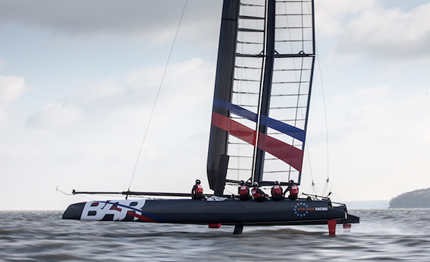PRESS
America's Cup, BAR: the fitter they are the faster they fly

redazione
The America's Cup is the oldest trophy in world sport – dating back to before the Ryder Cup, FIFA's World Cup and even the modern Olympics. It's also the only major sporting event that Britain has never won. Those failures – and there have been twenty of them – dot back through a time when the Cup was contested in majestic but distant yachts. Those yachts glided, apparently serenely across white-capped oceans. It was a limited view, accessible only to those who could get afloat, and not particularly accurate.
Technology, in the way of onboard cameras, eventually brought the audience onboard and revealed the truth. While it was serene from a distance – and sometimes it was even serene close-up – there were moments of frenzy onboard when the whole crew was moving. Huge men with lung capacities the size of Olympic rowers (several of them were) pounded at handles until their eyes bulged. And then they sat down and waited for the next moment of action. It could be 20 minutes away.
Those days are gone. There's nothing serene about the new America's Cup boats, not close-up, not even from a distance. The key to speed in the new America's Cup is achieving continuous stable 'flight' through ever changing conditions of wind and water. This requires constant adjustment of both hydrofoils and aerofoils, and that requires an equally constant supply of power. The majority of that power is supplied through a hydraulic system, similar to those used to control the flight surfaces of aircraft and F1 race cars.
In February 2010, the 33rd America's Cup was won by a 90 foot multihull. It used a 100hp car engine to provide the necessary power to the hydraulics. The 35th America's Cup will be raced in 48 foot foiling multihulls, and the rules state that there will be no engine. Instead, there will be just six crew. At all times, one of them will be required to adjust the hydrofoils, another to control the aerofoils. The other four must wind handles to feed the hydraulics with juice. They must keep it up for the entire race and, collectively, these six must weigh no more than 525kgs.
Before Ben Ainslie Racing's designers and engineers could sketch a single line of the boat that they hope will win the America's Cup, they needed to ask the sailing team one question; how much power could they deliver for the duration of the 30-40 minute races, raced twice a day, day after day for up to 20 days? The answer to that question is fundamental to the design of the boat. And the man in charge of delivering it is the team's strength and conditioning coach, Ben Williams.
"Previously America's Cup sailors were power/sprint athletes, like a 200m runner or a 100m runner," said Williams. "Now they are more akin to a 10km runner, or a rower, or a time trial cyclist because they are producing constant wattage without going into the red for 40 minutes. So they have become endurance athletes. We did a lot of development work and then went and talked to the design team about how much power we thought we could give them with the four guys in June 2017 (the date of the next America's Cup). They will use that number; so the amount of power the sailors can deliver is central to the design of the boat." Now all that Williams has to worry about is how to deliver on the promise, with a team of sailors talented enough at their craft, strong enough mentally and cohesive enough as a competitive unit to win the America's Cup. "I put all the aspects of that together and came up with a performance map," he explained.
"The more often I can deliver those guys to the boat uninjured with a maximum amount of energy and power ability, fully hydrated, the better they will become tactically, emotionally, physically and mentally. So we have created an environment where the most important thing is prehabilitation (training that aims to prevent injuries); mobility, flexibility, and the ability to get into different positions under load and not get injured. That forms the foundation of our training. Then we have the crew weight restrictions to consider, and we have to be able to create that defined amount of power."
"We've got this jigsaw, we've got all these great sailors and what we have got to do is find the right six that fit onto that boat so that there are no pieces missing. All while producing the target amount of power over long periods of time, being quick and agile, and making complex decisions under stress." Williams smiled, and added the line that I suspect will haunt the sailing team for the next two years. "It's not going to be easy, it's definitely not going to be fun, but it is definitely achievable."
by Mark Chisnell
29/04/2015 23:10:00 © riproduzione riservata
Tweet
CORRELATI
DELLA SETTIMANA
A Colico il Trofeo Allievi Alto Lario
Il vento ha fatto temere un tradimento, costringendo le regate a ritardare di quasi un’ora; è poi arrivato leggero insieme al sole per la prima prova, più forte nella seconda, mentre è calato nella terza
A Svezia, Francia e Germania i titoli di Campioni del Mondo ORC Double Handed 2025
Cinquantasette team in rappresentanza di dieci Nazioni si sono sfidati nell’alto Adriatico questa settimana per il Campionato Mondiale ORC Double-Handed 2025, ospitato dallo Yacht Club Monfalcone in collaborazione con l'Offshore Racing Congress (ORC)
Concluso il Campionato Europeo Windsurfer Class 2025 a Punta Ala
Si è concluso domenica 14 settembre, al Centro Velico Punta Ala, il Campionato Europeo Windsurfer Class 2025. Un’edizione che ha visto oltre 180 regatanti da 16 Paesi sfidarsi in cinque giornate di regata
Maxi Yacht Rolex Cup: il Maestrale la fa da padrone
Vincitori di giornata nelle rispettive classi sono stati V, Ganesha, H2O, Moat. Le prove a bastone per la classe Maxi Grand Prix non si sono potute svolgere per il vento molto intenso
La Maxi Yacht Rolex Cup si chiude in bellezza
Galateia e Django 7X vincono il Rolex World Championship rispettivamente nelle classi Maxi 1 e Maxi Grand Prix. I vincitori della 35^ Maxi Yacht Rolex Cup nelle altre classi sono: Oscar 3, H2O e Moat
Rigasa 2025: Line Honours per QQ7
QQ7 di Salvatore Costanzo conquista il Trofeo Mediolanum Cup; secondo posto per Freedom, il Solaris 50 da Edoardo Ridolfi e terzo posto per il Farr 30 Drago Volante
Chiude in festa il Sotto Gamba Game 2025
Si è conclusa a San Vincenzo (Livorno) la nona edizione del Sotto Gamba Game che si è svolta come sempre sotto il segno del superamento di ogni barriera e pregiudizio
Torbole: buon inizio del Mondiale di Windsurf Formula Foil
Il mondiale Windsurfing Formula Foil torna al Circolo Surf Torbole. In testa il tedesco Wolf; Primo junior e miglior italiano il giovane atleta del Circolo Surf Torbole Davide Scarlata
Mondiali Formula Windsurfing Foil: gran finale a Torbole
Il tedesco Fabian Wolf si sta confermando assoluto dominatore: con 12 vittorie su 15 prove e un punteggio netto di 12, il titolo mondiale sembra ormai saldamente nelle sue mani. Alle sue spalle, l’austriaco Theo Peter
Prima vittoria per il Red Bull Italy SailGP Team a Saint-Tropez
Un risultato che fa ben sperare, ma c'è ancora tanto da lavorare. Red Bull Italy chiude la prova di Saint Tropez al nono posto con 15 punti
